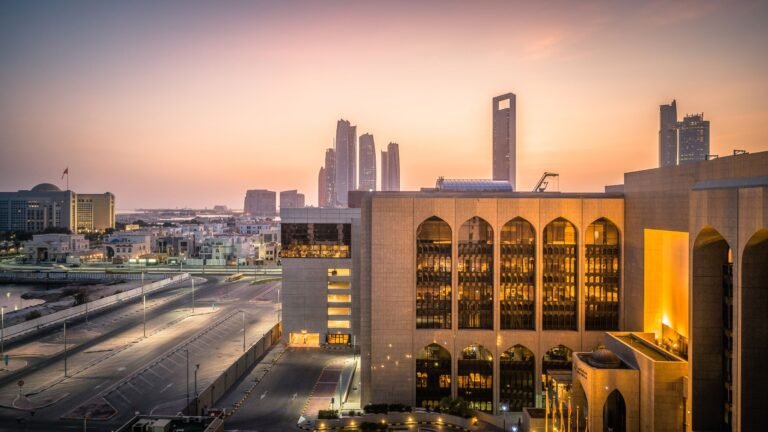The Central Bank of the United Arab Emirates (CBUAE) anticipates the country’s strong foreign trade performance to continue into 2024 and 2025, maintaining a projected growth rate for the UAE’s real GDP at 3.9 per cent in 2024, with expectations for it to further accelerate to 6.2 per cent in 2025.
In its June 2024 Economic Quarterly Review, the central bank noted that the country’s non-hydrocarbon GDP growth is expected to remain robust at 5.4 per cent in 2024 and 5.3 per cent in 2025, while the hydrocarbon sector is set to grow by 0.3 per cent in 2024, followed by an expansion of 8.4 per cent in 2025.
In the fourth quarter of 2023, the UAE economy expanded by 4.3 per cent year-on-year, surpassing the 2.5 per cent growth recorded in Q3 2023.
CBUAE GDP forecast
The quarterly growth is attributed to the acceleration of non-hydrocarbon growth, which accounts for approximately 75 per cent of GDP, along with improved performance in the hydrocarbon sector.
Recent figures also revealed that the consolidated fiscal balance in 2023 remained positive at AED 85.6B ($23.3B), equivalent to 4.5 per cent of GDP, with total revenue decreasing by 13.9 per cent to AED 526.1B ($143.2B/27.9 per cent of GDP).
Government expenditure increased by 3.1 per cent to AED 440.5B ($120B/23.3 per cent of GDP), the report added, noting that the fiscal sector remains sustainable and will be further strengthened by the recently introduced corporate income tax.
Indicators suggest robust economic activity within the non-oil private sectors, according to the CBUAE.
As of April 2024, the UAE’s Purchasing Managers’ Index (PMI) was reported at 55.3, driven by sustained business optimism regarding economic prospects. This positive sentiment is due to expectations of ongoing robust demand and sales, anticipated to support steady output growth.
New Initiatives and Investments
This outlook is further supported by the anticipation of new initiatives and investments.
Dubai recorded a PMI of 55.1 in April 2024, reflecting continued growth in the emirate’s non-oil private sector.
According to the data, the number of employees covered by the CBUAE Wage Protection System (WPS) and the average employee salary increased by 7.5 per cent and 9.4 per cent year-on-year in April 2024, respectively.
These positive indicators for employment and wage growth suggest robust domestic consumption and sustainable UAE GDP growth in the future.
The real estate, tourism and hospitality, and transportation sectors collectively account for about 30 per cent of the non-oil GDP, the report highlighted.
The number of residential real estate sales transactions in Abu Dhabi from January to April 2024 was estimated to have increased by 7.7 per cent year-on-year.
Growth was mainly driven by sales of ready units, which increased by 24.9 per cent year-on-year, while off-plan sales increased marginally by 0.8 per cent year-on-year.
Data for Q1 2024 indicated that Dubai maintained its role as a leading international tourism hub. The emirate’s hotel occupancy rates stood at 83 per cent, equal to the previous year’s figures, while the average duration of stay per visitor remained nearly unchanged at 3.9 nights, yet there was a 2 per cent year-on-year increase in the total occupied room nights, totalling 11.2M nights.
Additionally, Dubai recorded an 11 per cent rise in tourist arrivals in the first three months of 2024 compared to the same period last year, benefiting from the revival of global travel demand.
Abu Dhabi and Dubai Airports See Record-Breaking Visitor Numbers in Early 2024
During this period, the emirate welcomed 5.2M international overnight visitors, up from 4.7M tourists in the first quarter of the previous year.
Zayed International Airport received over 6.8M passengers in the first quarter of 2024, taking advantage of the top-tier facilities and services at its newly opened terminal in Abu Dhabi.
This emphasises Abu Dhabi’s status as a major transportation hub, with a 36 per cent increase in passenger numbers compared to the first quarter of 2023.
Dubai International Airport had an exceptional start to 2024, recording its busiest quarter ever, highlighting its importance as a global aviation hub and a major contributor to Dubai’s economy.
During the first quarter, there was a remarkable increase in passenger traffic, with 23M travellers passing through its facilities.
This represents an 8.4 per cent rise compared to the same period last year, underscoring its strong connection to key global markets and its role in strengthening Dubai’s status as a premier destination for both tourism and business.
Enhancing its status as a global travel and tourism hub, Dubai approved an ambitious AED 128B ($35B) project for a new passenger terminal at Al Maktoum International Airport.
This expansion will increase the size of Dubai’s main international airport fivefold, making it the largest in the world by size and capacity, capable of handling up to 260M passengers annually.


